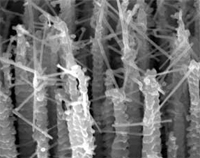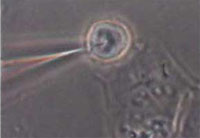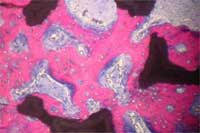Showing Spotlights 2569 - 2576 of 2851 in category All (newest first):
 Experts and the public generally differ in their perceptions of risk. While this might be due to social and demographic factors, it is generally assumed by scientists who conduct risk research that experts' risk assessments are based more strongly on actual or perceived knowledge about a technology than lay people's risk assessments. In the case of nanotechnology, surveys show that most people are not familiar with it. The public perception of an emerging technology will have a major influence on the acceptance of this technology and its commercial success. If the public perception turns negative, potentially beneficial technologies will be severely constrained as is the case for instance with gene technology. It seems plausible that the evaluation of new technologies, such as nanotechnologies, is guided by people's theories and values. For instance, people for whom the technological revolution is associated with positive outcomes - and who are not afraid of possible negative side effects of technological progress - may assess nanotechnology applications more positively than people for whom negative effects outweigh positive effects. Researchers in Switzerland conducted two studies which examined how lay people and experts perceived various nanotechnology applications and how companies address the public's concerns.
Experts and the public generally differ in their perceptions of risk. While this might be due to social and demographic factors, it is generally assumed by scientists who conduct risk research that experts' risk assessments are based more strongly on actual or perceived knowledge about a technology than lay people's risk assessments. In the case of nanotechnology, surveys show that most people are not familiar with it. The public perception of an emerging technology will have a major influence on the acceptance of this technology and its commercial success. If the public perception turns negative, potentially beneficial technologies will be severely constrained as is the case for instance with gene technology. It seems plausible that the evaluation of new technologies, such as nanotechnologies, is guided by people's theories and values. For instance, people for whom the technological revolution is associated with positive outcomes - and who are not afraid of possible negative side effects of technological progress - may assess nanotechnology applications more positively than people for whom negative effects outweigh positive effects. Researchers in Switzerland conducted two studies which examined how lay people and experts perceived various nanotechnology applications and how companies address the public's concerns.
Mar 30th, 2007
 Tremendous progress has been made over the past few years to control the aspects of fabricating simple nanostructures such as wires, tubes, spheres, cubes etc. However, in order to build functional nanodevices, for instance for nanoelectronics or nanobiotechnology, much more complex nanoarchitectures are needed. Initially, the most common, mostly top-down, fabrication methods used for this purpose have been based on nanolithographic techniques. Unfortunately, these methods are burdened with throughput restrictions and high cost and will be of limited use for commercial mass production of nanostructures. To overcome the limitations of nanolithography, a lot of attention has been focused on self-organized bottom-up approaches, which bear good prospects for large-scale fabrication of nanostructures with controlled morphology and dimensionality, and controlled synthesis of arrays. However, the fabrication of complex nanoarchitectures requires sophisticated transfer techniques, which are far from routine, time consuming, and with low reproducibility. To add to the arsenal of scaleable bottom-up fabrication processes, researchers in Germany have developed a method for the batch fabrication of 3D-nanostructures with tunable surface properties. Resembling suspended nanowire webs, these structures have a high potential for catalytic, sensing, or fluidic applications where a high surface to volume ratio is required.
Tremendous progress has been made over the past few years to control the aspects of fabricating simple nanostructures such as wires, tubes, spheres, cubes etc. However, in order to build functional nanodevices, for instance for nanoelectronics or nanobiotechnology, much more complex nanoarchitectures are needed. Initially, the most common, mostly top-down, fabrication methods used for this purpose have been based on nanolithographic techniques. Unfortunately, these methods are burdened with throughput restrictions and high cost and will be of limited use for commercial mass production of nanostructures. To overcome the limitations of nanolithography, a lot of attention has been focused on self-organized bottom-up approaches, which bear good prospects for large-scale fabrication of nanostructures with controlled morphology and dimensionality, and controlled synthesis of arrays. However, the fabrication of complex nanoarchitectures requires sophisticated transfer techniques, which are far from routine, time consuming, and with low reproducibility. To add to the arsenal of scaleable bottom-up fabrication processes, researchers in Germany have developed a method for the batch fabrication of 3D-nanostructures with tunable surface properties. Resembling suspended nanowire webs, these structures have a high potential for catalytic, sensing, or fluidic applications where a high surface to volume ratio is required.
Mar 29th, 2007
 People involved in designing and developing biosensing applications have high hopes that their field can benefit from nanotechnology. The term biosensing relates to systems that include electronic, photonic, biologic, chemical and mechanical means for producing signals that can be used for the identification, monitoring or control of biological phenomena. The resulting biosensors are devices that employ biological components such as proteins to provide selectivity and/or amplification for the detection of biochemical materials for use in medical diagnostics, environmental analysis or chemical and biological warfare agent detection. Applying nanotechnology to biosensors opens up novel detection possibilities thanks to the nano-physical properties of certain materials. A lot of research worldwide is devoted to developing nanobiosensors. A group in Switzerland, for example, is working on the development of two different kinds of label-free biosensors. One is a nanowire array, the other an optical biosensor based on localized surface plasmon resonance.
People involved in designing and developing biosensing applications have high hopes that their field can benefit from nanotechnology. The term biosensing relates to systems that include electronic, photonic, biologic, chemical and mechanical means for producing signals that can be used for the identification, monitoring or control of biological phenomena. The resulting biosensors are devices that employ biological components such as proteins to provide selectivity and/or amplification for the detection of biochemical materials for use in medical diagnostics, environmental analysis or chemical and biological warfare agent detection. Applying nanotechnology to biosensors opens up novel detection possibilities thanks to the nano-physical properties of certain materials. A lot of research worldwide is devoted to developing nanobiosensors. A group in Switzerland, for example, is working on the development of two different kinds of label-free biosensors. One is a nanowire array, the other an optical biosensor based on localized surface plasmon resonance.
Mar 28th, 2007
 Nanomaterials, with at least one dimension of 100 nanometers or less, are increasingly being used for commercial purposes such as fillers, opacifiers, catalysts, semiconductors, cosmetics, microelectronics, and drug carriers. Nanoparticles with a size of between 1 and 100 nanometers fall in the transitional zone between individual atoms (or molecules) and the bulk material. Because the physicochemical properties of material on this scale can greatly differ from the corresponding bulk material, these nanomaterials can have the potential to generate unknown biological effects in living cells. As the discussion on potentially undesired side effects of engineered nanoparticles heats up there is an increasing amount of nanotoxicology research that gets undertaken and published. However, very few studies have been conducted to assess the toxicity of nanomaterials to ecological terrestrial species, particularly plants. In order to develop a comprehensive toxicity profile for manufactured nanoparticles, their phytotoxicity - the ability to cause injury to plants - has to be investigated. A new study examined the effects of five types of nanoparticles on seed germination and root growth of six higher plant species and observed that several types of the particles had significant inhibition on seed germination and root growth of the six plants. If confirmed, these results are significant in terms of use and disposal of engineered nanoparticles.
Nanomaterials, with at least one dimension of 100 nanometers or less, are increasingly being used for commercial purposes such as fillers, opacifiers, catalysts, semiconductors, cosmetics, microelectronics, and drug carriers. Nanoparticles with a size of between 1 and 100 nanometers fall in the transitional zone between individual atoms (or molecules) and the bulk material. Because the physicochemical properties of material on this scale can greatly differ from the corresponding bulk material, these nanomaterials can have the potential to generate unknown biological effects in living cells. As the discussion on potentially undesired side effects of engineered nanoparticles heats up there is an increasing amount of nanotoxicology research that gets undertaken and published. However, very few studies have been conducted to assess the toxicity of nanomaterials to ecological terrestrial species, particularly plants. In order to develop a comprehensive toxicity profile for manufactured nanoparticles, their phytotoxicity - the ability to cause injury to plants - has to be investigated. A new study examined the effects of five types of nanoparticles on seed germination and root growth of six higher plant species and observed that several types of the particles had significant inhibition on seed germination and root growth of the six plants. If confirmed, these results are significant in terms of use and disposal of engineered nanoparticles.
Mar 27th, 2007
 Most of today's rocket engines rely on chemical propulsion. All current spacecraft use some form of chemical rocket for launch and most use them for attitude control as well (the control of the angular position and rotation of the spacecraft, either relative to the object that it is orbiting, or relative to the celestial sphere). Real rocket scientists though are actively researching new forms of space propulsion systems. One heavily researched area is electric propulsion (EP) that includes field emission electric propulsion (FEEP), colloid thrusters and other versions of field emission thrusters (FETs). EP systems significantly reduce the required propellant mass compared to conventional chemical rockets, allowing to increase the payload capacity or decrease the launch mass. EP has been successfully demonstrated as primary propulsion systems for NASA's Deep Space 1, Japan's HAYABUSA, and ESA's SMART11 missions. A new EP concept proposes to utilize electrostatically charged and accelerated nanoparticles as propellant. Millions of micron-sized nanoparticle thrusters would fit on one square centimeter, allowing the fabrication of highly scaleable thruster arrays.
Most of today's rocket engines rely on chemical propulsion. All current spacecraft use some form of chemical rocket for launch and most use them for attitude control as well (the control of the angular position and rotation of the spacecraft, either relative to the object that it is orbiting, or relative to the celestial sphere). Real rocket scientists though are actively researching new forms of space propulsion systems. One heavily researched area is electric propulsion (EP) that includes field emission electric propulsion (FEEP), colloid thrusters and other versions of field emission thrusters (FETs). EP systems significantly reduce the required propellant mass compared to conventional chemical rockets, allowing to increase the payload capacity or decrease the launch mass. EP has been successfully demonstrated as primary propulsion systems for NASA's Deep Space 1, Japan's HAYABUSA, and ESA's SMART11 missions. A new EP concept proposes to utilize electrostatically charged and accelerated nanoparticles as propellant. Millions of micron-sized nanoparticle thrusters would fit on one square centimeter, allowing the fabrication of highly scaleable thruster arrays.
Mar 26th, 2007
 Biosensors, which incorporate biological probes coupled to a transducer, have been developed during the last two decades for environmental, industrial, and biomedical diagnostics. The application of nanotechnology to biosensor design and fabrication promises to revolutionize diagnostics and therapy at the molecular and cellular level. The convergence of nanotechnology, biology, and photonics opens the possibility of detecting and manipulating atoms and molecules using a new class of fiberoptic biosensing and imaging nanodevices. These nanoprobes and nanosensors have the potential for a wide variety of medical uses at the cellular level. The potential for monitoring in vivo biological processes within single living cells, e.g. the capacity to sense individual chemical species in specific locations within a cell, will greatly improve our understanding of cellular function, thereby revolutionizing cell biology. Existing nanoprobes have already demonstrated the capability of performing biologically relevant measurements inside single living cells.
Biosensors, which incorporate biological probes coupled to a transducer, have been developed during the last two decades for environmental, industrial, and biomedical diagnostics. The application of nanotechnology to biosensor design and fabrication promises to revolutionize diagnostics and therapy at the molecular and cellular level. The convergence of nanotechnology, biology, and photonics opens the possibility of detecting and manipulating atoms and molecules using a new class of fiberoptic biosensing and imaging nanodevices. These nanoprobes and nanosensors have the potential for a wide variety of medical uses at the cellular level. The potential for monitoring in vivo biological processes within single living cells, e.g. the capacity to sense individual chemical species in specific locations within a cell, will greatly improve our understanding of cellular function, thereby revolutionizing cell biology. Existing nanoprobes have already demonstrated the capability of performing biologically relevant measurements inside single living cells.
Mar 23rd, 2007
 The market for medical implant devices in the U.S. alone is estimated to be $23 billion per year and it is expected to grow by about 10% annually for the next few years. Implantable cardioverter defibrillators, cardiac resynchronization therapy devices, pacemakers, tissue and spinal orthopedic implants, hip replacements, phakic intraocular lenses and cosmetic implants will be among the top sellers. Current medical implants, such as orthopaedic implants and heart valves, are made of titanium and stainless steel alloys, primarily because they are biocompatible. Unfortunately, in many cases these metal alloys with a life time of 10-15 years may wear out within the lifetime of the patient. They also might not achieve the same fit and stability as the original tissue, and in a worst case, the host organism might reject the implant altogether. While available implants can alleviate excruciating pain and allow patients to live more active lives, there often are problems getting bone to attach to the metal devices. Small gaps between natural bone and the implant can increase over time, requiring the need for additional surgery to replace the implant. In the quest to make bone, joint and tooth implants almost as good as nature's own version, scientists are turning to nanotechnology. Researchers have found that the response of host organisms (including at the protein and cellular level) to nanomaterials is different than that observed to conventional materials. While this new field of nanomedical implants is in its very early stage, it holds the promise of novel and improved implant materials.
The market for medical implant devices in the U.S. alone is estimated to be $23 billion per year and it is expected to grow by about 10% annually for the next few years. Implantable cardioverter defibrillators, cardiac resynchronization therapy devices, pacemakers, tissue and spinal orthopedic implants, hip replacements, phakic intraocular lenses and cosmetic implants will be among the top sellers. Current medical implants, such as orthopaedic implants and heart valves, are made of titanium and stainless steel alloys, primarily because they are biocompatible. Unfortunately, in many cases these metal alloys with a life time of 10-15 years may wear out within the lifetime of the patient. They also might not achieve the same fit and stability as the original tissue, and in a worst case, the host organism might reject the implant altogether. While available implants can alleviate excruciating pain and allow patients to live more active lives, there often are problems getting bone to attach to the metal devices. Small gaps between natural bone and the implant can increase over time, requiring the need for additional surgery to replace the implant. In the quest to make bone, joint and tooth implants almost as good as nature's own version, scientists are turning to nanotechnology. Researchers have found that the response of host organisms (including at the protein and cellular level) to nanomaterials is different than that observed to conventional materials. While this new field of nanomedical implants is in its very early stage, it holds the promise of novel and improved implant materials.
Mar 22nd, 2007
 Nanocrystals, also called quantum dots (QD), are artificial nanostructures that can possess many varied properties, depending on their material and shape. For instance, due to their particular electronic properties they can be used as active materials in single-electron transistors. Because certain biological molecules are capable of molecular recognition and self-assembly, nanocrystals could also become an important building block for self-assembled functional nanodevices. The atom-like energy states of QDs furthermore contribute to special optical properties, such as a particle-size dependent wavelength of fluorescence; an effect which is used in fabricating optical probes for biological and medical imaging. So far, the use in bioanalytics and biolabeling has found the widest range of applications for colloidal QDs. Though the first generation of quantum dots already pointed out their potential, it took a lot of effort to improve basic properties, in particular colloidal stability in salt-containing solution. Initially, quantum dots have been used in very artificial environments, and these particles would have simply precipitated in 'real' samples, such as blood. These problems have been solved and QDs are ready for their first real applications.
Nanocrystals, also called quantum dots (QD), are artificial nanostructures that can possess many varied properties, depending on their material and shape. For instance, due to their particular electronic properties they can be used as active materials in single-electron transistors. Because certain biological molecules are capable of molecular recognition and self-assembly, nanocrystals could also become an important building block for self-assembled functional nanodevices. The atom-like energy states of QDs furthermore contribute to special optical properties, such as a particle-size dependent wavelength of fluorescence; an effect which is used in fabricating optical probes for biological and medical imaging. So far, the use in bioanalytics and biolabeling has found the widest range of applications for colloidal QDs. Though the first generation of quantum dots already pointed out their potential, it took a lot of effort to improve basic properties, in particular colloidal stability in salt-containing solution. Initially, quantum dots have been used in very artificial environments, and these particles would have simply precipitated in 'real' samples, such as blood. These problems have been solved and QDs are ready for their first real applications.
Mar 21st, 2007
 Experts and the public generally differ in their perceptions of risk. While this might be due to social and demographic factors, it is generally assumed by scientists who conduct risk research that experts' risk assessments are based more strongly on actual or perceived knowledge about a technology than lay people's risk assessments. In the case of nanotechnology, surveys show that most people are not familiar with it. The public perception of an emerging technology will have a major influence on the acceptance of this technology and its commercial success. If the public perception turns negative, potentially beneficial technologies will be severely constrained as is the case for instance with gene technology. It seems plausible that the evaluation of new technologies, such as nanotechnologies, is guided by people's theories and values. For instance, people for whom the technological revolution is associated with positive outcomes - and who are not afraid of possible negative side effects of technological progress - may assess nanotechnology applications more positively than people for whom negative effects outweigh positive effects. Researchers in Switzerland conducted two studies which examined how lay people and experts perceived various nanotechnology applications and how companies address the public's concerns.
Experts and the public generally differ in their perceptions of risk. While this might be due to social and demographic factors, it is generally assumed by scientists who conduct risk research that experts' risk assessments are based more strongly on actual or perceived knowledge about a technology than lay people's risk assessments. In the case of nanotechnology, surveys show that most people are not familiar with it. The public perception of an emerging technology will have a major influence on the acceptance of this technology and its commercial success. If the public perception turns negative, potentially beneficial technologies will be severely constrained as is the case for instance with gene technology. It seems plausible that the evaluation of new technologies, such as nanotechnologies, is guided by people's theories and values. For instance, people for whom the technological revolution is associated with positive outcomes - and who are not afraid of possible negative side effects of technological progress - may assess nanotechnology applications more positively than people for whom negative effects outweigh positive effects. Researchers in Switzerland conducted two studies which examined how lay people and experts perceived various nanotechnology applications and how companies address the public's concerns.
 Subscribe to our Nanotechnology Spotlight feed
Subscribe to our Nanotechnology Spotlight feed





